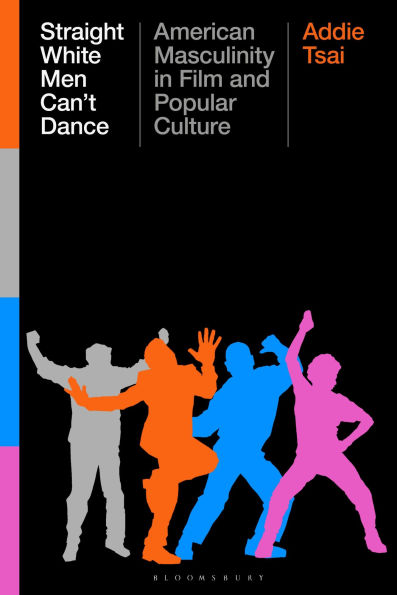Straight White Men Can't Dance: American Masculinity in Film and Popular Culture investigates a trope proliferating throughout popular American media over the last half-century: that straight white men can't dance.
Addie Tsai traces this reiterative moving image of vaudevillian buffoonery in film, television, and video from the mid-1980s to present-day. During the height of homophobic hysteria in response to the AIDS epidemic, dance began to be used as a marker to scrutinize white men's position within homosexuality and masculinity. Therefore, white men could misperform good dancing to more securely sit within hegemonic masculinity.
Tsai establishes how ethnic mimicry within American popular media, even that of white masculinity, is produced and reiterated from the 19th-century theatrical practice of blackface minstrelsy. This history resurfaces in one of the exceptions to the trope: when white men use the hip currency of blackness to affirm their (dancing) masculinity through theft and positionality.
By revealing how dance in American popular media reifies and problematizes gendered and racialized economies, Straight White Men Can't Dance demonstrates how the image of the buffoonish white male dancer operates as a smokescreen for the more violent manipulative forces of the reigning figure of white supremacy.
1147010415
Addie Tsai traces this reiterative moving image of vaudevillian buffoonery in film, television, and video from the mid-1980s to present-day. During the height of homophobic hysteria in response to the AIDS epidemic, dance began to be used as a marker to scrutinize white men's position within homosexuality and masculinity. Therefore, white men could misperform good dancing to more securely sit within hegemonic masculinity.
Tsai establishes how ethnic mimicry within American popular media, even that of white masculinity, is produced and reiterated from the 19th-century theatrical practice of blackface minstrelsy. This history resurfaces in one of the exceptions to the trope: when white men use the hip currency of blackness to affirm their (dancing) masculinity through theft and positionality.
By revealing how dance in American popular media reifies and problematizes gendered and racialized economies, Straight White Men Can't Dance demonstrates how the image of the buffoonish white male dancer operates as a smokescreen for the more violent manipulative forces of the reigning figure of white supremacy.
Straight White Men Can't Dance: American Masculinity in Film and Popular Culture
Straight White Men Can't Dance: American Masculinity in Film and Popular Culture investigates a trope proliferating throughout popular American media over the last half-century: that straight white men can't dance.
Addie Tsai traces this reiterative moving image of vaudevillian buffoonery in film, television, and video from the mid-1980s to present-day. During the height of homophobic hysteria in response to the AIDS epidemic, dance began to be used as a marker to scrutinize white men's position within homosexuality and masculinity. Therefore, white men could misperform good dancing to more securely sit within hegemonic masculinity.
Tsai establishes how ethnic mimicry within American popular media, even that of white masculinity, is produced and reiterated from the 19th-century theatrical practice of blackface minstrelsy. This history resurfaces in one of the exceptions to the trope: when white men use the hip currency of blackness to affirm their (dancing) masculinity through theft and positionality.
By revealing how dance in American popular media reifies and problematizes gendered and racialized economies, Straight White Men Can't Dance demonstrates how the image of the buffoonish white male dancer operates as a smokescreen for the more violent manipulative forces of the reigning figure of white supremacy.
Addie Tsai traces this reiterative moving image of vaudevillian buffoonery in film, television, and video from the mid-1980s to present-day. During the height of homophobic hysteria in response to the AIDS epidemic, dance began to be used as a marker to scrutinize white men's position within homosexuality and masculinity. Therefore, white men could misperform good dancing to more securely sit within hegemonic masculinity.
Tsai establishes how ethnic mimicry within American popular media, even that of white masculinity, is produced and reiterated from the 19th-century theatrical practice of blackface minstrelsy. This history resurfaces in one of the exceptions to the trope: when white men use the hip currency of blackness to affirm their (dancing) masculinity through theft and positionality.
By revealing how dance in American popular media reifies and problematizes gendered and racialized economies, Straight White Men Can't Dance demonstrates how the image of the buffoonish white male dancer operates as a smokescreen for the more violent manipulative forces of the reigning figure of white supremacy.
103.5
Pre Order
5
1

Straight White Men Can't Dance: American Masculinity in Film and Popular Culture
216
Straight White Men Can't Dance: American Masculinity in Film and Popular Culture
216Related collections and offers
103.5
Pre Order

Product Details
| ISBN-13: | 9781350443594 |
|---|---|
| Publisher: | Bloomsbury Publishing |
| Publication date: | 08/21/2025 |
| Sold by: | Barnes & Noble |
| Format: | eBook |
| Pages: | 216 |
| File size: | 449 KB |
About the Author
From the B&N Reads Blog
